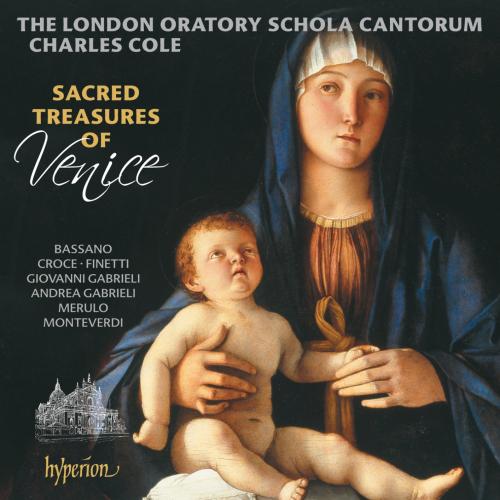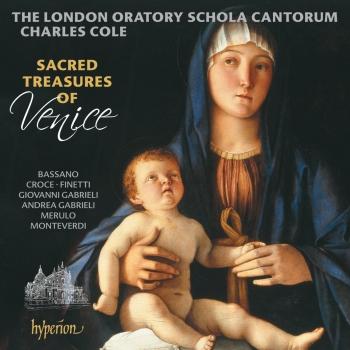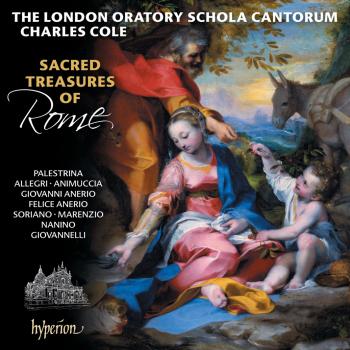
Sacred Treasures of Venice: Motets from the Golden Age of Venetian Polyphony London Oratory Schola Cantorum & Charles Cole
Album info
Album-Release:
2024
HRA-Release:
02.02.2024
Label: Hyperion
Genre: Classical
Subgenre: Choral
Artist: London Oratory Schola Cantorum & Charles Cole
Composer: Giovanni Gabrieli (1557-1612), Giovanni Bassano (1557-1617), Claudio Merulo (1533-1604), Claudio Monteverdi (1567-1643), Giacomo Finetti (1605-1631), Andrea Gabrieli (1510-1586), Giovanni Croce (1557-1609)
Album including Album cover Booklet (PDF)
I`m sorry!
Dear HIGHRESAUDIO Visitor,
due to territorial constraints and also different releases dates in each country you currently can`t purchase this album. We are updating our release dates twice a week. So, please feel free to check from time-to-time, if the album is available for your country.
We suggest, that you bookmark the album and use our Short List function.
Thank you for your understanding and patience.
Yours sincerely, HIGHRESAUDIO
- Giovanni Gabrieli (1554 - 1612):
- 1 Gabrieli: Jubilate Deo omnis terra, C. 136 05:19
- 2 Gabrieli: Beata es virgo Maria, C. 8 04:34
- 3 Gabrieli: Ego sum qui sum, C. 29 04:43
- 4 Gabrieli: O quam suavis a 7, C. 10 05:08
- Giovanni Bassano (1560 - 1617):
- 5 Bassano: Dic nobis Maria 04:00
- Claudio Merulo (1533 - 1604):
- 6 Merulo: Adoramus te Domine 02:55
- 7 Merulo: Beata viscera 02:55
- Claudio Monteverdi (1567 - 1643):
- 8 Monteverdi: Adoramus te Christe, SV 289 05:53
- 9 Monteverdi: Cantate Domino a 6, SV 293 03:43
- Giacomo Finetti (1605 - 1631):
- 10 Finetti: O crux ave, spes unica 03:41
- Andrea Gabrieli (1510 - 1586):
- 11 Gabrieli: Laetare Jerusalem 03:39
- 12 Gabrieli: Maria Magdalene, Maria Jacobi, et Salome 04:36
- Giovanni Croce (1557 - 1609):
- 13 Croce: Cantate Domino 02:29
- 14 Croce: O sacrum convivium a 4 03:16
- 15 Croce: In spiritu humilitatis 05:45
- 16 Croce: Buccinate in neomenia 03:52
Info for Sacred Treasures of Venice: Motets from the Golden Age of Venetian Polyphony
It’s tempting to imagine that this is how the music might have sounded four centuries ago in the glorious surroundings of St Mark’s. Certainly, any comparisons are unlikely to be to the disadvantage of these exceptional young singers: this is repertoire in which they excel.
Although Monteverdi would ultimately dominate the early Venetian Baroque, a remarkable period immediately preceded his arrival at San Marco—the period of the ‘Three Giovannis’. It is almost impossible to imagine such great talents as Giovanni Gabrieli, Giovanni Bassano and Giovanni Croce all working alongside each other in the same place at the same time, but such a unique situation could only have existed at St Mark’s: Gabrieli as First Organist, Bassano as maestro of instrumental music, and Croce as the overall maestro di cappella, all three of them writing music of incredible quality.
Giovanni, the younger of the two Gabrielis, studied with Lassus in Munich during the 1570s before returning to Venice, where he was appointed Second Organist at St Mark’s in 1584, rising to First Organist the following year on the death of the incumbent, his uncle Andrea. The First and Second Organists would alternate week by week, covering all duties in the Basilica alone; however, both were required for major feasts, when the primo would accompany the choir, the secondo playing with the instruments and accompanying soloists. Giovanni Gabrieli’s famous eight-part setting of Jubilate Deo draws together a number of verses from the psalms, including the text ‘Deus Israel coniugat vos’, the word ‘coniugat’ undoubtedly recalling in the minds of the Venetians the annual conjoining of the Doge and the lagoon in the ceremonial marriage of the Serenissima and the sea. A relatively late work, not published until a year after his death, the absolute mastery of the construction and its polished craftsmanship show Gabrieli at the height of his powers. Interestingly though, it is harmonically far more conservative than the next three motets, which were published as part of Gabrieli’s earlier 1597 collection Symphoniae sacrae I. The six-part Beata es virgo Maria was intended for the Feast of the Assumption of the Virgin, and the double-choir Ego sum qui sum is a setting of a Matins text for Easter Sunday. In these, Gabrieli is more willing to exert a gentle pressure on the tonality. The wondrous sonorities which arise are especially spectacular in the seven-part O quam suavis for Corpus Christi which includes a poignant quotation of the Gregorian second-mode Magnificat tone at ‘dimittens inanes’. The powerful downward melodic gestures in the trebles at ‘demonstrares’ meet with opposing upward force in the lower voices, bracing the harmonic structure, whilst the final cadence, arguably unsurpassed in this anthology, achieves a fragile and delicate beauty like the finest Murano vase. ....
London Oratory Schola Cantorum
Charles Cole, conductor
London Oratory Schola Cantorum
The Schola Cantorum of The London Oratory School sings at the London Oratory every Saturday evening in term time and on major feast days for School Mass throughout the year. Founded in 1996, the choir gives Catholic boys the opportunity of a choral education within the state education system from age 7 to 18. As well as its liturgical role, the Schola has made many recordings and has toured widely abroad, performing throughout the USA and Europe.
In 2013 the Schola sang at High Mass in St Peter’s Basilica in Rome, and was the first visiting choir in history to sing at Vespers there. In 2015 the Schola toured Spain, singing a programme of Spanish renaissance polyphony at the Cathedrals of Madrid, Segovia and Toledo as well as the Monastery of San Lorenzo el Real in El Escorial. In 2016 the Schola toured Venice singing Mass at St Mark’s and a concert at the Church of San Salvador. The same year the Schola sang at a choral festival in Bavaria with the Tölzer Knabenchor. In 2017 the Schola toured southern Spain singing in Seville and Granada. Later in 2017 the Schola went on tour to the USA singing in Boston, New York and Washington DC.
In July 2019 the Schola undertook a major tour in the USA, singing at the Cathedral of the Madeleine, Salt Lake City, at a number of the Californian Missions, as well as the first concert at the newly-consecrated Christ Cathedral, Orange County. In October 2019 the Schola was invited to sing at the Canonisation of John Henry Newman at St Peter’s, Rome. The choir also sang a number of services and concerts in Rome leading up to the Canonisation, a reception attended by H.R.H. The Prince of Wales and a private audience with the Pope Emeritus, Benedict XVI.
The Schola’s most recent recording, Sacred Treasures of Spain, was released in July 2019 on the De Montfort/AimHigher Recordings label. This anthology of Spanish renaissance music follows the Schola’s previous recording, Sacred Treasures of England, which features music from the Tudor period. The Choir is closely associated with Aid to the Church in Need, singing for services and events to help the Charity’s work in providing support to persecuted Christians, most particularly in Syria and Iraq. The Trebles also sing for a number of the Royal Ballet’s productions at the Royal Opera House including The Dream and Nutcracker.
Recent performances by the Schola include J.S. Bach’s St John & St Matthew Passions and the Christmas Oratorio at the London Oratory with evangelist Nicholas Mulroy and Monteverdi’s Vespers with the English Cornett & Sackbut Ensemble.
Booklet for Sacred Treasures of Venice: Motets from the Golden Age of Venetian Polyphony












